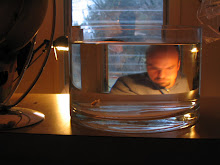Ever wonder where that universal symbol for pause, used on audio and video equipment for decades now, came from? It's not arbitrary; instead, it's derived from the literary and musical symbols for a caesura, or break. Here's the jauntily diagonal musical variant:
Signs, signs: at the MICA commencement speech this year, James Turrell announced that he wanted to speak about signs. He told a story about a Native American acquaintance of his who suggested that people themselves can be signs, to other people. The first white men to land on this continent? Signs of a coming change. And so on: even as we look for omens in the world about us, we may be read as portents, too.
How does Cleo, then, see me? What do I signal to her? I would expect that the answer is more or less conventional. Structure, order. Support and encouragement, I hope. A potential playmate or monster, when needed. But somehow (and it still astounds me), she does not yet see me as a sign of restrictiveness, or distasteful authority, or - the parent's mind sags - age, or decline, or a foil to her own identity and sense of social currency. In short, she still smiles broadly and openly when she sees me (or L., of course) as I arrive in the playground. 'Daddy!' she cries.
And that, I often think, is the most wonderful sign of all.




No comments:
Post a Comment